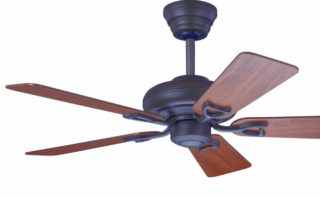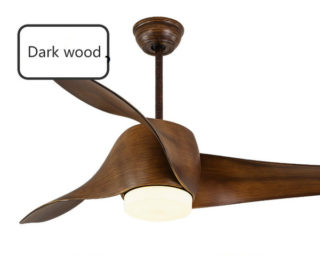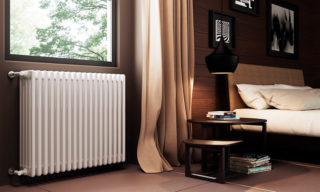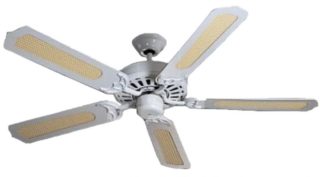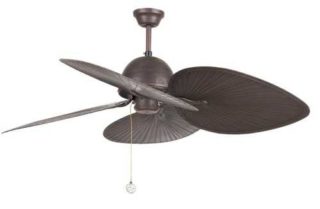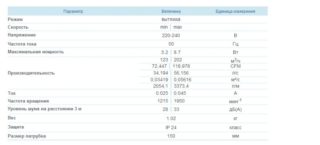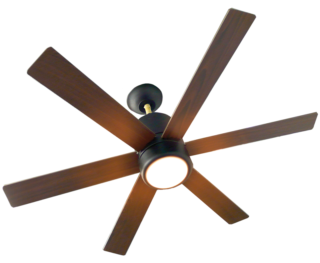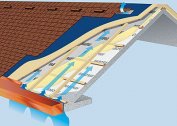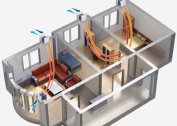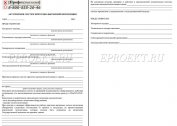An effective option for cooling the air in the room is a ceiling fan. It works more economically compared to popular air conditioning and creates comfort at elevated temperatures. The device is safe for humans, as does not cause colds due to hypothermia. The unit works effectively on open areas of restaurants, in industrial shops and warehouses, where it is not practical to use air conditioning.
The principle of operation of the ceiling fan
Air movement is created in the room, while heat is dissipated from the human skin and a cooling effect is created. The ambient temperature remains the same, so you do not need to adapt to stressful changes.
The fan consists of the following elements:
- Electrical engine;
- case box;
- blades;
- mounting bracket or bracket.
The unit is mounted so that foreign structures and objects, for example, chandeliers, door leafs, furniture, ceiling beams, do not fall into the rotation zone.
Performance Options
The horizontal angle of the blades determines the productivity, which increases with increasing ramp. This creates an additional load on the engine.
The vertical tilt angle affects the amount of space captured by the room. If the angle between the barrel and the blades is less than 90 °, the extreme points of the room are cooled, and right under the fan the flow effect is weakened.
Climate humidity affects performance. In rooms with a lower rate, the fan gives less efficiency, and in damp rooms the cooling effect is more pronounced.
Ceiling fan application
Units create a light wind effect, this method does not require large expenditures and is used in various circumstances. The reverse function allows you to switch the operating modes that are provided for summer and winter.
In axial rotation models, the air flow is parallel to the central axis and moves due to the positive rotation angle of the impeller. Centrifugal fans drive the flow on the oncoming blades and direct it radially relative to the rotational axis under the action of centripetal force.
In summer
In summer, the airflow from the device goes down. The blades rotate counterclockwise when viewed upward, standing under the center of the impeller. Ceiling units provide coolness by blowing a person’s body.
A hanging fan is one of the few devices besides portable devices that creates comfort on a summer outdoor veranda or in a garden gazebo. There are combined designs with a chandelier, at the same time cooling and lighting the territory of street buildings.
In winter
In winter, stratification of the warm and cold flow is observed, the first rises to the ceiling, and fresh accumulates in the lower part of the room. In high rooms of trading floors (up to 6 m), the temperature difference is 8 - 10 ° С, therefore, the cost of heating the lower zone of the passage of people increases.
Costs grow even more if the upper heated layers go into exhaust ventilation. The paddle ceiling fan accelerates warm air horizontally along the ceiling, then from top to bottom along the walls.The temperature is evened out, heating costs are reduced, people in the working area do not feel discomfort from the cold.
Options when selecting
The diameter of the blades plays a role. In a large room or hall, several units are placed in order to achieve the desired effect.
The size is selected from the parameters of the room and destination:
- small rooms (2.5 x 3.0 m), bathrooms, kitchens, bathrooms - 30` (762 mm);
- medium rooms (3.6 x 5.0 m) - 42` (1066 mm);
- large areas (5.5 x 6.0 m) - 52` (1320 mm).
Height is taken into account, so devices on a long shaft will not be suitable for low ceilings. Power affects the performance of the outboard equipment, but strong units require the installation of a separate power supply branch.
Emitted noise
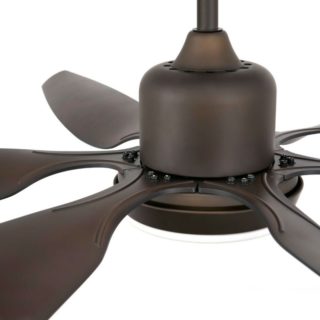
Sometimes fans buzz and cause discomfort to those present. To make it more silent, you need to balance the units.
Procedure Procedure:
- turn off the device and wait for the impeller to stop;
- check and tighten the blade mounts;
- remove dust from the surface, especially in the upper region (the layer presses on the bearings and causes a squealing sound);
- check rubber gaskets in the impeller attachment to the metal flange;
- the blades are placed on the same level with the help of a balancing kit, which is in stores, the set is used according to the instructions.
There is a room fan on the ceiling with a DC motor. Such units are low noise and feature quiet operation.
Speed direction and rotation
The direction of movement of the impeller determines the movement of the air flow in the room. Summer and winter working hours depend on this.
Reverse suspension units are divided into types:
- with manual switching of the direction of rotation;
- using the remote control.
In the first models, the switch is located on the case, while for cooling the handle is placed down, and for mixing heated and cold air, the handle is placed up.
Type and shape of the blades
The device moves more air with an increase in wing area. But a wide surface reduces the gap between the blades and reduces the degree of flow intake. If the fan has more than six flat elements or they have a peculiar palm shape, the installation does not always cope with the shoveling of the air mass.
The effectiveness is affected by the number of blades in the structure. For example, devices with three wings mix more volume than a device with four blades when operating at the same speed.
The ability to replace the blades
Changing the impeller is carried out if the device does not drive air flows well and can not cope with the task.
To change the blades, you need to disassemble the fan:
- the front mesh is unscrewed and removed;
- the propeller is disconnected, which is fastened with a nut with a left-hand thread;
- the rear safety net is removed;
- the box fasteners are unscrewed, the engine is lubricated and a new impeller is put.
The rotation of the central rod is checked, the fan casing is mounted in reverse order.
Rotational speed
The speed of rotation of the impeller indicates the speed of the fan motor. With an increase in the number of turns over a period of time, the efficiency of blowing increases. Speed controllers are used, which include a backlight with a button and a handle for coordination. The device shows the working or inoperative state of the fan.
The controller allows you to stop working or turn on the outboard turbine without changing the speed and change the speed without turning off the device.One regulator can be placed on two units, but the power of the devices should not be greater than the coordinator's similar indicator.
Power
Productivity shows the amount of air mass transported by the unit for 1 hour of operation, measured in m³ / h. Powerful appliances are installed for large rooms in order to achieve air movement in distant points and corner areas.
The power of fans, which have a large wingspan, is always higher, because additional force is required to rotate the long levers. Productive fans consume more electricity from the mains.
Additional functions
Most units provide for the adjustment of height, tilt in the horizontal and vertical plane and the automatic turn function.
Optional devices in outboard fans:
- The electronic timer sets the clock, programs the mode for a day or a week, changes occur automatically.
- A low-power battery is installed in the chandelier fans, which does not provide rotation of the blades, but guarantees lighting for two hours when the power is turned off.
- Built-in motion sensors start the installation when people appear in the room.
An automatic humidity reader is installed in the bathtub for an extraordinary start. Models are equipped with a high-frequency ionizer and atmosphere flavor.
Norms and Rules
SNiP 2.09.04 - 1987 “Administrative and Domestic Buildings” regulates the mandatory installation of ceiling units in regions where the outdoor temperature in summer is above + 25 ° C.
Rules for handling the device:
- Do not touch the fan with wet hands or stop the blades while the engine is on;
- it is not allowed to use the unit to small children;
- in the presence of flammable alcohol, gasoline, acetone vapors, the fan does not turn on;
- the blades should be installed no lower than 2.3 m from the floor in the room.
For use, mandatory grounding of the fan parts is required. The power of the device must match the bandwidth of the power source.
Benefits of Ceiling Fan
Overhead coolers are chosen for ease of installation and low cost compared to installing an air conditioning system. Fans consume little electricity, the power is comparable to that of a light bulb.
The ceiling type does not take up much space, the wires do not stretch across the room, the installation of bulky wall-mounted control units is not required. A wide selection of models makes it affordable for all categories of customers.
